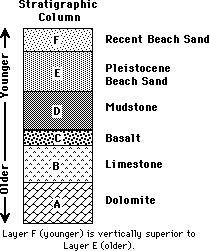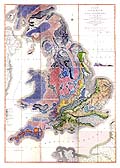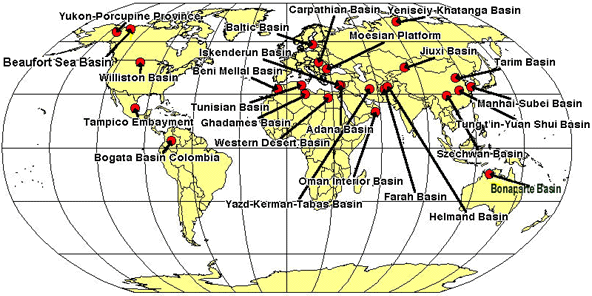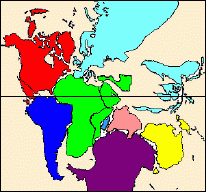|
The Law of Superposition
|
|

 Superposition -- It's a Law : One of the most fundamental principles of archaeology is the Law of Superposition. The law states that strata that are younger will be deposited on top of strata that are older, given normal conditions of deposition. This law is the guiding principle of stratigraphy, or the study of geological or soil layers. Stratigraphy is still the single best method that archaeologists have for determining the relative ages of archaeological materials.
Superposition -- It's a Law : One of the most fundamental principles of archaeology is the Law of Superposition. The law states that strata that are younger will be deposited on top of strata that are older, given normal conditions of deposition. This law is the guiding principle of stratigraphy, or the study of geological or soil layers. Stratigraphy is still the single best method that archaeologists have for determining the relative ages of archaeological materials.
Geologic Time: Relative Time Scale : James Hutton and William Smith advanced the concept of geologic time and strengthened the belief in an ancient world. Hutton, a Scottish geologist, first proposed formally the fundamental principle used to classify rocks according to their relative ages. He concluded, after studying rocks at many outcrops, that each layer represented a specific interval of geologic time. Further, he proposed that wherever uncontorted layers were exposed, the bottom layer was deposited first and was, therefore, the oldest layer exposed; each succeeding layer, up to the topmost one, was progressively younger. The Major Divisions of Geologic Time are shown here, arranged in chronological order with the oldest division at the bottom, the youngest at the top.
Relative Time, Superposition and Cross-cutting Relationships : Geologic intrusions, faults and uncon-formities are explained and pictured.
|
|
Geologic Stratigraphy
|
|
Stratigraphy and Cross-Dating/Biostratigraphy : Stratigraphy is the study of strata, or layers. Specifically, stratigraphy refers to the application of the Law of Superposition to soil and geological strata containing archaeological materials in order to determine the relative ages of layers. Cross-dating is a technique used to correlate parts of a site or different sites, and objects or strata with a known relative chronology. A specialized form of cross-dating, using animal and plant fossils, is known as biostratigraphy.

 William "Strata" Smith [1769-1839], a civil engineer and surveyor, was well acquainted with areas in southern England where "limestone and shales are layered like slices of bread and butter." His hobby of collecting and cataloging fossil shells from these rocks led to the discovery that certain layers contained fossils unlike those in other layers. Using these key or index fossils as markers, Smith could identify a particular layer of rock wherever it was exposed. Because fossils actually record the slow but progressive development of life, scientists use them to identify rocks of the same age throughout the world. See more information about "Strata" Smith and his original geologic map of England. Information about Simon Winchester's delightful biography of Smith, The Map That Changed the World is available at amazon.com. Click on the map to see a larger version.
William "Strata" Smith [1769-1839], a civil engineer and surveyor, was well acquainted with areas in southern England where "limestone and shales are layered like slices of bread and butter." His hobby of collecting and cataloging fossil shells from these rocks led to the discovery that certain layers contained fossils unlike those in other layers. Using these key or index fossils as markers, Smith could identify a particular layer of rock wherever it was exposed. Because fossils actually record the slow but progressive development of life, scientists use them to identify rocks of the same age throughout the world. See more information about "Strata" Smith and his original geologic map of England. Information about Simon Winchester's delightful biography of Smith, The Map That Changed the World is available at amazon.com. Click on the map to see a larger version.
Correlation by Fossils : Correlation means matching the order of geologic events in one place with the order of geologic events in another place. By far, the most widespread method of correlation uses fossils
Index Fossils : Keyed to the relative time scale, index fossils are the forms of life which existed during limited periods of geologic time and thus are used as guides to the age of the rocks in which they are preserved.
Complete Geologic Column at 25 Worldwide Locations
 Source: www.talkorigins.org/faqs/geocolumn/basin3.gif
Source: www.talkorigins.org/faqs/geocolumn/basin3.gif
The Entire Geologic Column in North Dakota: A detailed examination of the young earth creationist claim that the geologic column does not exist. It is shown that the entire geologic column exists in North Dakota. A considerable list is given of other sites around the world where the complete geologic column is found. The map above is part of this www.talkorigins.org FAQ. Massive floods leave massive evidence in the geological record. None of these 25 geologic column sites give correlated evidence of a massive, worldwide flood at any time during at least the last 600 million years (to the base of the Cambrian).
Geological Society of America - About the Flood : The journal GSA Today places one major research paper per issue online with free access. The May 2025 issue is represnted by Persistent Holocene Outflow from the Black Sea to the Eastern Mediterranean : A contradiction of the Noah's Flood Hypothesis.
Berkeley Geology : Exploring this series of exhibits will take you on a journey through the history of the Earth, with stops at particular points in time to examine the fossil record and stratigraphy.
Rocks of Ages : From U. S. Geologic Service. Describes, with particular references to the U.S., the periods, epochs, geography and physical features leading to the present landscape.
Maps and Other Resources : Federal and State agencies involved in land resources and mapping.
Online Map Creation : Want to see the fault lines around the Andes, fast? This site in Germany will make a map of any part of the world in various projection types (Mercator, polar stereographic, etc.) and stamp it with tectonic features. You can enter coordinates or zoom around to the spot you want.
|
|
The Watery World
|
|
USGS Real-Time Water Data :
Using the map you can select the ~10 nearest stations to the point you click, a list of all the stations in a state, or an interactive map of a state. You also may use a list to obtain data by state.
Life In The Smoking Zone : The hydrothermal vents -- essentially geysers on the sea floor -- support exotic chemical-based ecosystems. Some scientists think the vents are modern-day examples of environments where life began on Earth billions of years ago. And the vents might also hold clues to life on other planets.
Life on the Arctic Sea Floor : Photosynthesis is not the only basis for life: locally, methane and hydrogen sulfide seep from the ocean floor, supporting oases of organisms that depend on bacteria able to consume these chemicals. Chemosynthetic life doesn't directly depend on sunlight and can thrive at great depths.
Voyage to the Deep! :
Take a dive in the Alvin to deep sea vents, and see the benthic community.
The website is very graphics heavy and slow to load using a 14.4kb modem. But it's worth the trip.
Oceans : Chemistry and Life : How the oceans formed and then......
Tsunami Research Program :
seeks to mitigate hazards to Hawaii and Pacific Northwest states.
|
|
Seismic Monitoring
|
|
Recent Earthquakes for Los Angeles : There were 23 earthquakes (1.2 - 2.2 seismic scale) on the map that was current when I logged this website. Click on any earthquake on maps for more information. There is an index map, big earthquake list, all earthquakes list and maps for Long Valley, Los Angeles and San Francisco. Maps are updated within about 5 minutes of an earthquake or once an hour.
Global Seismic Hazard Assessment Program :
GSHAP was launched in 1992 by the Int'l Lithosphere Program with the support of the International Council of Scientific Unions and endorsed as a demonstration program in the framework of the United Nations Int'l Decade for Natural Disaster Reduction.
Live Internet Seismic Server :
Displays live data from seismographic stations around the world.
The IRIS Consortium :
IRIS is a university research consortium dedicated to exploring the Earth's interior through the collection and distribution of seismographic data.
IRIS programs contribute to scholarly research, education, earthquake hazard mitigation, and the verification of a Comprehensive Test Ban Treaty.
Yellowstone Blast!: The hot spot, an upwelling plume of hot mantle beneath the Yellowstone Plateau caused massive and sudden eruptions 2.0 million, 1.3 million, and 0.6 million years ago. Yellowstone may be once again poised for a disastrous event, perhaps within the next 100,000 years. Such an eruption would change the world's climate for years, and might wipe out civilization. Also see the Yellowstone Volcano Observatory.
|
|
Volcano Studies
|
|
Volcano World :
Listings Sorted by: World Region, Country/Area, Volcano Name, Volcano Descriptions
Volcano Hazards Program : From U.S. Geologic Survey. Volcano Hazards, Active U.S. Volcanoes, Historical eruptions, Reducing Volcanic Risk, Emergency planning, Warning schemes, Resources
Axial Volcano Page :
In January 1998, Axial Volcano experienced a submarine volcanic eruption. Research cruises to Axial every summer since then with ROPOS have been documenting changes at the site caused by the eruption. More information about this work can be found at the New Millennium Observatory website, where daily updates are posted when scientists are at sea.
How Volcanoes Work : Volcano taxonomy and terminology. The site describes what happens during an eruption and tells why some eruptions are explosive and others aren't. (Magma viscosity and temperature are key.) Spectacular illustrations include photographs, maps, and animations of eruptions that take you into the belly of a volcano. Includes vivid descriptions of historical eruptions, spiced by firsthand accounts from survivors. Links to webcams allow you to keep tabs on active volcanoes such as Mt. St. Helens and Mt. Etna.
Latin American Volcanoes : This website holds maps of volcanoes in each country and links to outside Web pages on specific ones -- photos, activity reports, live Web cams, and much more.
Weekly Volcanic Activity Report : Right now, some of the world's more than 1500 active volcanoes are fuming, burping, trembling, spurting, shifting, bulging, oozing, or maybe even blowing their top. Get a brief rundown at this site which charts new and continuing "unrest" at places like the notorious Soufrière Hills volcano on the Caribbean island of Montserrat, where eruptions beginning in 1995 destroyed the capital city and drove more than half of the population into exile.
Volcanic Lake Research: Tiwo Nua Muri Koohi Fah on the Indonesian island of Flores is one of the planet's 80 or so volcanic lakes, bodies of water trapped within a crater. Find out more about these intriguing lakes -- some of which may replicate the torrid, chemical-rich conditions under which life first appeared.
Kilauea Volcano :
From the U.S.G.S. Hawaiian Volcano Observatory, which sits at the edge of Kilauea's crater, scientists post daily reports, eye-catching photos, video, maps, and data such as readings from tiltmeters that monitor the slope of the ground, an indicator of lava buildup beneath the summit.
|
|
Paleoclimatology
|
|
Ancient Global Land Environments : 150,000-year Quaternary vegetation atlas. The well-trafficked site offers some interesting insights. During the last glaciation around 20,000 years ago, for instance, the central African, Asian, and Amazon rainforests all shrank.
Speleothem Microfabrics : If you want to find out what the climate was like ages ago, one way is to grab a flashlight and head for a cave. Stalagmites, stalactites, and other mineral deposits known as speleothems contain chemical and mineralogical clues to past rainfall and temperatures. This Atlas of Speleothem Microfabrics brims with dozens of images of the formations under a microscope.
NOAA Paleoclimatology Program : Scientists build a picture of ancient climate using all sorts of indirect clues, from tiny ocean fossils to the rings of old trees. The world's official storehouse for these "proxy data" is the National Oceanic and Atmospheric Administration's Paleoclimatology Program. Its Web site also offers loads of links and useful background information.
Paleoclimatology and Paleoceanography : For a list of essential paleoclimate links, visit this website. You'll find academic institutions and journals, societies and databases, tutorials, and much more.
U.S. Global Change Research Program: Looking for updated measurements of atmospheric carbon dioxide since 1958 or the latest on the relation between global warming and disease outbreaks? Each month, the site lists new material on press releases, news articles, government reports, and congressional testimony.
|
|
Field Trips and Museum Tours
|
|
Geology Central : Virtual Geology Field Trip and Geology Links.
The Dawn of Animal Life Exhibit : While most people know of the dinosaurs from a mere 70 million years ago, few know that the Earth's fossil record stretches over 3 billion years into the past. Using Canadian rocks and fossils, this exhibit highlights almost three billion years of early evolution when only simple, soft-bodied creatures inhabited the Earth. From the Miller Museum of Geology, Queen's University, Kingston, Ontario.
Field Trip to a Glacier: Glaciers are frozen, slow-moving rivers that carve canyons, create lakes, and bulldoze soil. The Glacier Image Database illustrates the structure of these giant tongues of ice, like Alaska's Holgate Glacier, and the geological features they form, such as the trails of rubble called moraines.
Antarctic Meteorite Recovery Expedition 2025: Through the journal entries, photos, and other materials posted here, you can follow this year's ANSMET expedition to the frigid but meteorite-rich Darwin Glacier area, 300 kilometers from McMurdo Station.
|
|
Photo Archives
|
|
Operational Significant Event Imagery : High-resolution, detailed imagery of events visible in remotely-sensed data available at the NOAA Science Center in Suitland, Maryland. Offerings range from a total solar eclipse over Europe to dust storms over the Arabian Desert to calving icebergs in Antarctica.
USGS Media for Science :
A large photo library from The U.S. Geological Survey
Terrain Sciences in Canada : Want to see what a tombolo looks like, or perhaps a pingo? Photos of landscapes and landforms illustrate the great diversity of Canadian scenery.
Geology by Lightplane : New Mexico's Shiprock -- the internal remains of an extinct volcano -- is just one geologic feature with an elevated perspective on this earthly topic. The site is stocked with aerial photos of mountains, mesas, and canyons taken largely in the mid-1960s. A clickable map leads to breathtaking vistas.
TerraFly:
You can take a virtual flight over Washington, D.C., Miami Beach or San Francisco at TerraFly, while viewing aerial photographs and satellite images. The site lets you type in a U.S. address and get a bird's-eye photo (in black and white) then pan across it, seamlessly moving onto adjacent images.
|
|
Answers to Frequently Asked Questions
|
|
The Galileo Project :
Life and work of Galileo Galilei (1564-1642) and the science of his time. From Rice Univ.
The Recession of the Moon and the Age of the Earth-Moon System : For the Creationist expert who throws out arguments based on a brief reading of oddities in nature. Point them to this website.
Oldest Crystal Reveals Early Earth : The chemical signature of a mineral sample determined to be the world's oldest known terrestrial material suggests early Earth was cool enough to have water, continents and conditions that could have supported life. The 4.4-billion-year-old sample may also undermine accepted views about the formation of the moon. And a Timeline and Rock Photo.
Polonium Halos: A Creationist "Problem" Explained : Radon is formed in nearby U238 deposits. As gas, it moves freely through cracks in granite rocks, which themselves have no uranium. Radon decays into Polonium as it flows through the rock. The Granite, cooled and crystalline, is thus exposed to a constant supply of Polonium atoms which incorporate themselves chemically into the crystalline structure of the rock, and explode, forming the Polonium halos.
|
|
More About Geology
|
|
Origin of Methane/Oil in the Earth's Crust : Recent discoveries of the widespread presence of bacterial life at depth point to this as the origin of the biological content of petroleum.
Climate Trends Online : . Climate change predictions are based on a wide range of data, from recent stats on methane belched by rice fields to ice core temperature records going back more than 400,000 years.
Latitude: Fifteenth-Century Navigation : Links lead to treatises on the science of mapmaking and to the Great Globe Gallery, a clearinghouse of hundreds of maps and images, ranging from depictions of continental drift to the worldwide distribution of coral reefs.
Cornell's Geoscience Information System: Create and download multilayered maps based on 100 geology, geography, and geophysics data sets covering national, regional, and global scales. They include structure of Earth's crust, location of faults, earthquake and volcanic events, magnetic and gravity measurements, details of surface topography, and descriptions of aquifers.
Arctic Circle: To some, the Far North is a treasure trove of minerals and fossil fuels ready to be harvested. Others see their traditional home or a priceless wilderness deserving protection. At Arctic Circle, you can immerse yourself in the history and cultures of the area above the 66th parallel and explore current debates on resource use, land rights, and cultural identity.
New Electron Microprobe Determines Ages of Rocks: A team of University of Massachusetts geologists is exploring a new way to determine the ages of ancient rocks, and refining our understanding of the timing and rates of the geologic events that have shaped the planet. The new method offers greater efficiency, and access to a much more detailed geologic record than current dating methods, the scientists say.
Petrology of Carbonate Hardgrounds: Hardgrounds, synsedimentarily lithified carbonate sea-floors, are fascinating geological and biological systems. They are found throughout the Phanerozoic in sufficient numbers to be geologically useful, yet well-preserved examples are scarce enough to be of unusual interest. See also: College of Wooster Geology Courses
Geomagnetism : Much as the ozone layer fends off DNA-scarring ultraviolet radiation, Earth's magnetic field shelters us from the solar wind. This U.S.G.S. site keeps tabs on the magnetic field, which comes mostly from the motion of molten iron within Earth's core.
Changing Views of the History of the Earth : The best estimate of the age of the Earth today is the same as that for meteorites: 4.55 ± 0.02 billion years. If one wishes to be extra cautious in reporting a value, using the very generous error range of 4.5 ± 0.1 billion years is almost certain to encompass any future changes.
|
|
Other Web Directories
|
|
Geology and Geophysics : Like this page, tries to provide well-selected topical links (extensive)
Geological Society of America - Current Journals : Full access requires pdf reader.
Geography and Earth Science: Want to find out how global warming might affect the climate of your state? Or how many earthquakes rattled Earth today? Try this roundup of earth science and physical geography links.
GeoExplorer : This is a guide to geography on the web. This web site is packed full of links and web resources to support students and teachers of geography or those with a general interest in geography.
|


 Also see
Also see 

 Source: www.talkorigins.org/faqs/geocolumn/basin3.gif
Source: www.talkorigins.org/faqs/geocolumn/basin3.gif